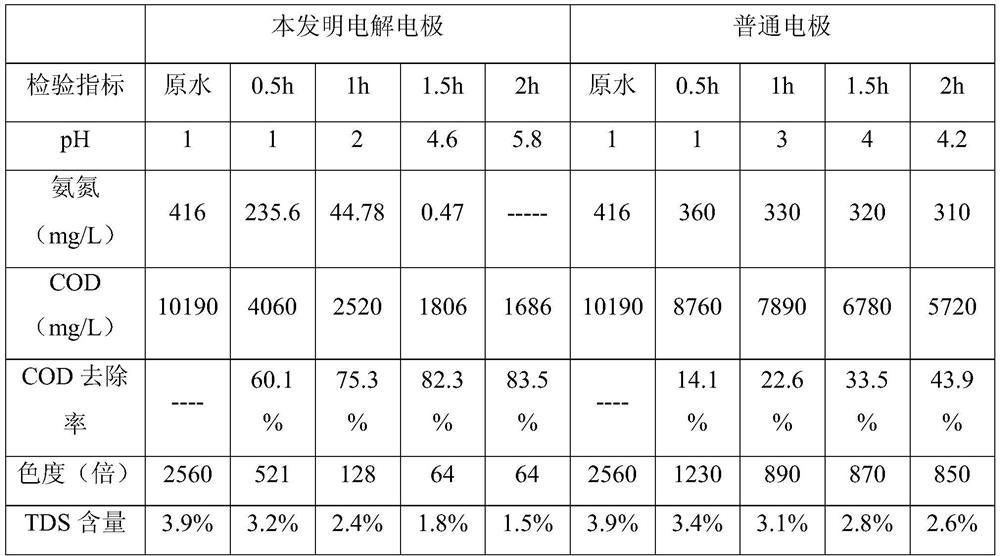A high-salt and high-cod wastewater electrolysis electrode and electrolytic oxidation treatment method
An electrolytic electrode and electrolytic oxidation technology, which is used in water/sewage treatment, water treatment parameter control, chemical instruments and methods, etc., can solve the problems of short electrode service life, low electrolytic oxidation efficiency, and electrode life reduction, and achieve stable electrolysis. , the effect of stable voltage and current, low power consumption
- Summary
- Abstract
- Description
- Claims
- Application Information
AI Technical Summary
Problems solved by technology
Method used
Image
Examples
Embodiment 6
[0044] This embodiment is an electrolysis experiment of a single strand of wastewater in a pharmaceutical factory workshop. The experimental power supply uses a DC pulse constant current source with a constant current of 9A and a voltage of 4.2V. The raw water samples and the indicators of electrolysis for 1 hour, 2 hours and 3 hours were tested respectively.
[0045] The results are as follows:
[0046] Inspection index Raw water sample 1h 2h 3h pH 6 5 5.5 6 Ammonia nitrogen (mg / L) 731 476 228 ----- COD (mg / L) 42640 29040 16650 2550 COD removal rate ------ 31.9% 60.95% 94.1% CL - (mg / L)
[0047] As can be seen from the above table, the removal rate of ammonia nitrogen is 100%, and the removal rate of COD is 94.1%. It can be seen that the electrolytic electrode of the present invention has a stronger removal effect for ammonia nitrogen and COD in sewage.
Embodiment 7
[0049] This embodiment is an electrolysis experiment of high-concentration (high-salt and high-COD) wastewater from a pharmaceutical factory. The experimental power supply uses a DC pulse constant current source with a constant current of 9A and a voltage of 3.2V. The raw water samples and the indicators of electrolysis for 1 hour, 2 hours and 3 hours were tested respectively.
[0050] The results are as follows:
[0051] Detection Indicator Raw water sample 1h 2h 3h pH 6 5.8 5.8 5.9 Ammonia nitrogen (mg / L) 2017 1283 276 ----- COD (mg / L) 136010 93950 52190 17330 COD removal rate ----- 31.0% 61.6% 87.3% CL - (mg / L)
[0052] As can be seen from the above table, the removal rate of ammonia nitrogen is 100%, and the removal rate of COD is 87.3%. It can be seen that the electrolytic electrode of the present invention has a stronger removal effect for ammonia nitrogen and COD in sewage.
Embodiment 8
[0054] This embodiment is an electrolysis experiment of comprehensive wastewater from a pharmaceutical factory. The experimental power supply uses a DC pulse constant current source with a constant current of 9A and a voltage of 4.8V. The raw water samples and the indicators of electrolysis for 1 hour, 2 hours and 3 hours were tested respectively.
[0055] The results are as follows:
[0056] Detection Indicator Raw water sample 1h 2h 3h pH 6 6 5.8 5.8 Ammonia nitrogen (mg / L) 675 437 203 ---- COD (mg / L) 43380 28305 14729 3826 COD removal rate ---- 34.8% 66.1% 91.2% CL-(mg / L) 600 590 570 550 TDS content (mg / L) 1% 1% 0.9% 0.8%
[0057] As can be seen from the above table, the removal rate of ammonia nitrogen is 100%, and the removal rate of COD is 91.2%. It can be seen that the electrolytic electrode of the present invention has a strong removal effect for ammonia nitrogen and COD in sewage.
PUM
| Property | Measurement | Unit |
|---|---|---|
| thickness | aaaaa | aaaaa |
Abstract
Description
Claims
Application Information
 Login to View More
Login to View More - R&D
- Intellectual Property
- Life Sciences
- Materials
- Tech Scout
- Unparalleled Data Quality
- Higher Quality Content
- 60% Fewer Hallucinations
Browse by: Latest US Patents, China's latest patents, Technical Efficacy Thesaurus, Application Domain, Technology Topic, Popular Technical Reports.
© 2025 PatSnap. All rights reserved.Legal|Privacy policy|Modern Slavery Act Transparency Statement|Sitemap|About US| Contact US: help@patsnap.com

